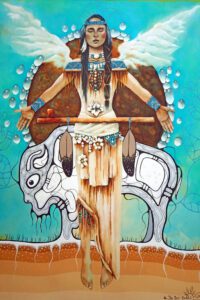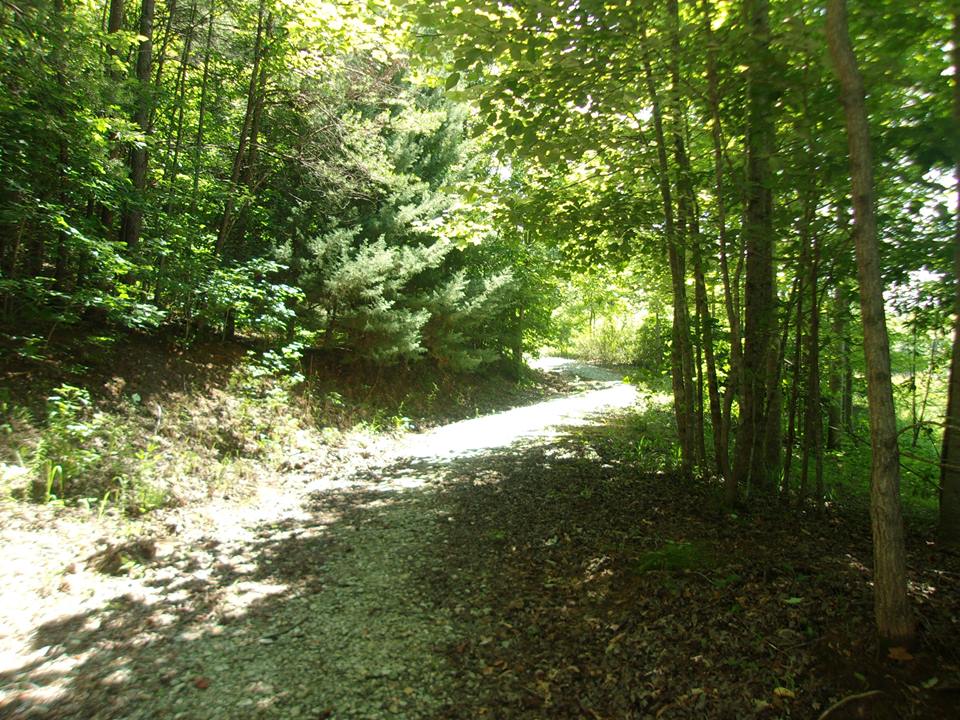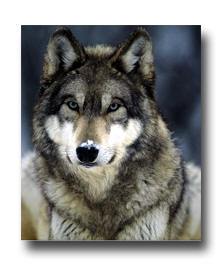As he arrived at his den, Brother Coyote thought about what Brother Eagle and Sister Cougar had said. He thought about how it had been getting colder with each passing day. He remembered their words that the People and Chief Buffalo did not know if the Sun would ever come back. He thought about how disappointed Chief Buffalo had been with him. The more he thought about it, the angrier he became.
“Why should this be my responsibility?” he cried, “I didn’t ask for this burden! I just want to play in the forest! I don’t want to go on any journey!”
As he thought about it, he grew angrier and angrier. He became so mad that he began to chase his tail. He ran around and around in circles on the ground. The faster he chased his tail, the faster it ran away from him, and the more frustrated he became.
Thus preoccupied, he didn’t notice at first that a mysterious white substance had begun falling from the sky. It fell thicker and thicker around him until finally he could not help but notice. Puzzled, he caught a flake of this stuff on his tongue, and found that it was cold and tasteless. As he watched, the snow covered the ground, obliterating the dying plants as it fell. The air around him grew colder and colder.
Shivering, Coyote curled himself up into a ball to stay warm as the snow continued to fall.
As lay there on the ground tucked into a ball, watching the snow, Coyote began to think that it would never stop.
“Truly this is the end of all things!” he thought to himself, “I might as well just lie here and freeze to death!”
Soon the strange white stuff completely covered Coyote. Lying there buried in the snow, he had begun to compose his Death Song when he saw a faint light shining in the distance. As he watched, it grew closer and closer. He eventually saw that the light shone from atop a stick being held by a woman dressed in the color of the snow that surrounded her. The light on her stick looked like a miniature sun, and she was bringing it towards him. He was frightened, but also cold. If that miniature sun gave off heat as well as light, how he wanted to be near it! So he did not run away, but waited patiently as the woman dressed in white approached and sat next to him.
“Greetings, Brother Coyote,” she said, “I am White Buffalo Woman.”

Coyote was usually wary of strangers, but something about White Buffalo Woman put him at ease. She seemed wise and kind, so he greeted her and began to tell her his story. He told her that the People were frightened because of the cold, and that they were worried that it might never be warm again. He told her that the People wanted him to go on a quest to find a new place for the Tribe to live, but that he was afraid to go.
“It is wise that you are afraid,” she told him, “Only fools are fearless in the face of the unknown. But that does not mean you shouldn’t go.”
As they talked, White Buffalo Woman gathered sticks and twigs and began arranging them in a pile in front of Coyote. When the pile was big enough, she touched her glowing stick to the pile, and it blossomed into heat and light. Almost instantly, Brother Coyote felt himself begin to thaw. The heat spreading across his body was almost magical.
“What is this strange thing?” he asked.
“It is called ‘fire,’” said White Buffalo Woman, “If you have its secret, your People will not have to move away to a new place. With fire, you may stay warm through the winter until the spring comes again.”
“What is ‘winter’?” asked Coyote, “and ‘spring?’”
“Winter is the reason it is cold now. It is a time known as a ‘season.’ Spring is also a season. Winter is a time of cold, decay, and death, and springe is a time of warmth and rebirth. Seasons come and seasons go, but when the time of winter has passed, the spring will return again. Fire will help you make it through the cold and dark of winter. Until then, you must be vigilant and wait for spring’s return.”
Coyote was amazed at the magical power of the fire. He was also glad to know that spring would come again, but if the People did not have this magical thing to help them through the winter, they may not live to see it.
Coyote and White Buffalo Woman sat warming themselves by the fire and talking. White Buffalo Woman told Coyote that the fire had come from a sacred village in the mountains to the North, where it was guarded by a greedy witch who wanted to keep it for herself. She told Coyote that if he followed the North Star he could find this village, and claim some of the fire to call his own.
“But why can’t I just have some of your fire?” Brother Coyote asked.
“Because each person must find his own fire, and this fire is mine,” replied White Buffalo Woman, smiling enigmatically. “It would not work for you because it is my fire. You could not make it burn.”
They talked for half of the night
until White Buffalo Woman lay down in front of the fire to sleep. Coyote tried
to sleep himself, but after hearing of the village of the Fire Tribe, the fire,
and the witch who guarded it, he was more frightened than ever. Yet he knew
that he was the only one who could make this journey. When he had resolved for
himself that he must be the one to go, he finally fell asleep just before dawn.
When he awoke the next morning, White Buffalo Woman was gone, and the fire had
gone out.
3.0 Supernatural Aid and Your Fears
Just as Coyote began to grow cold and numb in the snow, when we deny our emotions we open ourselves up to the process of emotional numbing. We kid ourselves into believing that certain emotions are “wrong” or “bad,” and we hide them away. We don’t want to own these parts of ourselves. Sometimes emotional injuries can lead to this state of numbing as well. The feelings are so powerful that they become overwhelming, so we learn to stuff them down and pretend they don’t exist so we don’t have to go through the pain of feeling them. Over time this denial of what we feel can make it difficult, if not impossible, to acknowledge our feelings at all. When this emotional numbing occurs, we have to actively work to “thaw out” our feelings. Sometimes we may do this by relying on our own Supernatural Aid.
To find your own Supernatural Aid, first ask yourself if there are there any fears that might have led to your own emotional numbing in life. Like Coyote, do you need to “thaw out” those feelings? How might the characteristics of a shaman help you to do so?
It can be difficult to answer the Call to Adventure. When our emotions freeze us into inaction out of habit, it sometimes becomes hard to choose a different path. When faced with the opportunity (or challenge) to discover new ways of being, our fight or flight response often takes over, and we remain stuck in the familiar. It can be scary to journey off into unknown territory, simply because it is unknown. But using mindful awareness in the present moment we can become aware that the unknown is just that…unknown. Dangers may lie ahead, but great rewards may lie ahead as well.
We only change when the pain of staying the same becomes greater than the pain of changing. Every action has a consequence, and answering the Call to Adventure is an action with unknown consequences. Answering the call means facing our fears. It means facing our pain. It is an acknowledgement that with great risk comes great reward. It is a willingness to risk it all in order to gain ourselves.
Ultimately, the Call to Adventure is about inspiration. Ecospirituality is all about finding that which is awe-inspiring in our own lives. When we find that source of inspiration, then the “fire” of our own Supernatural Aid comes to warm us. Your own Supernatural Aid will come to assist you when you realize that there are no other options but the path you’re on. All other doors have been closed to you, and from that point on the only choice is to heed the call.
3.1 Finding Your Own Fire
At the end of your journey on the Way of the Coyote you will be able to live according to your own true nature, in True Self. You are a unique individual, with your own needs, wants, talents and skills. Because of this, you can never walk another’s path. There are similarities along the journey that we all share. We all need basic necessities like food, clothing, and shelter. We all need to love and to be loved. We all search for a deeper meaning to give our lives purpose.
On the other hand, there are things that are true only of you. Your “fire” cannot be someone else’s fire. Your journey is unique, and the things you will experience on the way will be yours and yours alone. Remember that when you seek your own Supernatural Aid, it will come to you in a form that only you may understand.
We all have inner voices that guide us along the way. We also have other voices that may have shaped our walk. These voices may have come from parents, or from partners, or from friends, or from teachers, or even from strangers.
When seeking the path of ecospirituality, the ultimate destination is your own True Self. This means that at the end of the journey we have learned to live according to our own true nature, and not according to expectations or life goals that others have implanted in our consciousness. It means learning to listen to the voice of your own inner wisdom, and learning to be able to distinguish that voice from all of the other voices that may have guided us through the years.
When your own Supernatural Aid helps you to find your own fire, that fire will be yours and yours alone, and not the fire of your parents, your mate, your friends, your children, or of anyone else.
3.2 Nature as Supernatural Aid
“If you really think that the environment is less important than the economy, try holding your breath while you count your money.”
-Dr. Guy McPherson, University of Arizona
I grew up on a 400 acre farm in the 1960s and 1970s. Back then there were no video games, and the television only got three channels, and that was if the wind was blowing in the right direction. My best friend lived five miles away, and if we wanted to visit each other we had to ride our bikes or walk. Our after-school entertainment consisted of building forts in the woods, taking hikes, fishing, or collecting plants and animals. Growing up this way not only allowed me an opportunity for fresh air, it also stimulated my imagination and curiosity. The mythology of my time consisted of stories from my Irish great-grandmother about Native Americans, faeries and Celtic lore, and Christian tales from my Scottish grandmother about the biblical patriarchs.

I was never much interested in the Christian mythology, as it mostly seemed to consist of people getting zapped by God for doing things in a way that displeased him. And he seemed to be displeased quite a bit. The Native American and Celtic lore were much more alive to me. Those stories were not black-and-white moral tales, but puzzlers where the right answer was often difficult to find. The more I studied these stories, the more I gained insight into myself and the world around me.
As I became much more acquainted with mythology and learned to interpret it not as literal stories, but as teaching metaphors, fables, and parables, I returned to some of those Bible stories and got a lot more out of them the second time around. If you look at those stories as teaching tools and not as literal textbook descriptions of actual places and people, they become useful again. They come alive again. The secret is to focus on the message and not on the messenger.
This poetical use of story and myth can also extend to nature. It is possible to use the wilderness as a metaphor for spiritual growth. In fact, many religious mythologies do just that. When Jesus asks us to, “Consider the lilies of the field’ which don’t toil or spin, yet they’re complete,” or when Buddha tells us that, “The Way lies in the nature that surrounds us,” these spiritual teachers are using nature as a training manual.
A lot of the great enlightened teachers began their spiritual journeys by going off into the woods. Buddha did it, Jesus did it, Mohammed did it, Moses did it, the Native Americans did it, and so did most of the great spiritual masters throughout history. There is something about seeing the wild places firsthand that awakens our deeper, more intimate and more personal levels of awareness. It is a rite of passage that uses nature to give meaning to our lives while returning to our most primal instincts.
Science in recent years has begun studying the psychological aspects of wilderness experiences. In a 2005 study, van den Berg & Heijne researched some of these characteristics. The study, Fear versus fascination: An exploration of emotional responses to natural threats, explains that there are two basic types of attention: focus and fascination.
Focus is the type of attention we experience most often in artificial environments. Human hands make most, if not all, of the things we see indoors. Since we evolved in the wilderness, but have only been living in increasingly artificial environments for a few thousand years, our brains are wired to be on guard in unfamiliar surroundings. The more primitive parts of our brains recognize artificial places as somehow alien. Because of this, we tend to use more energy to focus our attention while indoors in order to avoid these man-made distractions.
Fascination is the type of attention we experience more outdoors. The deeper, older parts of our brains recognize natural environments as something familiar, so we tend to use less mental resources for focusing attention. This means that more mental energy is available to generate more meditative states. So unless a bear is chasing you, you’re calmer and more relaxed in the woods or on a beach than in an office or classroom. Such serenity is a prerequisite to spiritual events, so experiences in nature are highly conducive to developing more spiritual awareness.
Such ecospiritual awareness, enhanced and induced by nature, is not about a particular religion. All religions contain aspects of nature, and all religions, when understood properly, hold a deep reverence for the natural environment. The Way of the Coyote is about fostering a spiritual connection by using nature as a tool to experience those awe-inspiring moments that make life worthwhile. When nature is experienced in this way, it is a Supernatural Aid to the seeker. Sitting or hiking quietly in the woods or in another natural environment will allow your own inner wisdom to come forth. This Supernatural Aid will help you to find your own fire of inspiration.
3.3 Animal Wisdom
At the start of Coyote’s journey, he has answered the Call to Adventure and has overcome the Refusal of the Call. Like Coyote, at this point in the journey you are about to undertake a new, sometimes dangerous, quest through unfamiliar territory. It’s as if you are about to go into an uncharted, deep, dark forest without a map. It is dangerous because it is leaving the familiar behind and venturing off into unknown territory. Such a challenge can be quite daunting. This is why, in most legends and on most spiritual quests, some sort of Supernatural Aid is required to begin.
If you have a belief in any supernatural entity, then by all means feel free to call upon your own higher power for assistance. But such a belief is not necessary in order to tap into the supernatural powers of nature for guidance. There are several ways to do this, and all of these ways involve using nature as a teaching metaphor. Any metaphor will work, but for our purposes in the ecospirituality program, my favorite type of supernatural assistance is Animal Wisdom.
If you’re a sports fan, you’re no stranger to the fact that many professional sports teams are named after animals. There’s the Chicago Bears, the Carolina Panthers, the Atlanta Falcons, the Philadelphia Eagles, etc. We also use animal names as terms of endearment (for example, “Teddy Bear”) or as nicknames (Richard the Lionhearted, or King Arthur, whose name means “The Bear”). This tendency is a vestige of a time when we lived closer to nature. We choose these nicknames because certain animals have specific characteristics. In using these names for ourselves, our loved ones, and our sports teams, we are either consciously or unconsciously invoking the characteristics of those animals. We are using the archetypal energy of animals to make changes in ourselves.
Animal wisdom is the wisdom our totem animals give to us. A totem animal is an animal soul that functions as a teacher, companion and helper. Some consider the practice of taking a totem animal as the practice of drawing the archetypal energy of that animal into yourself, while others believe that animal spirits are real and assist us in our endeavors. Regardless of what you may personally believe about the actual existence of animal totems or spirit animals, you may call upon the archetypal energy of your animal totems to help you begin your journey. You may also call upon them at any time during the quest, should the going become difficult.
Do you have an affinity for a certain animal? My wife and I both love cats, and she collects cat figurines and pictures. Other friends I know collect cows, pigs, bears, etc. When I ask people about their reasons for collecting a particular animal, the usual response is, “I don’t know, I just like cats (or dogs, or whatever).”
If you have a favorite animal, have you ever stopped to think about why? What is it about that particular animal that attracts you? There is an almost universal tradition in indigenous spiritual paths of taking a totem animal. Sometimes even whole tribes took on the name of a particular animal (The Wolf Clan of the Cherokee people would be an example). Obviously, such connections with the animal world are important. But why are they important? Think about your favorite animal for a moment. You may have more than one favorite animal. If that is the case, pick the one that first comes to mind. Picture that animal clearly in your mind. It may help to do a mindful meditation while focusing only on your chosen animal. When you feel that you have established a connection in your mind with your animal, go on to the My Animal Totem exercise at the end of this section.

You may have more than one animal helper, but most of us have a primary power animal who serves as a helper. If you have answered the Call of the Coyote, it is safe to say that Coyote is probably one of your totem animals. In order to call upon your own supernatural aid to begin the quest, you must first find your own spirit animal. You may already have at least one. If so, that’s okay. But if not, here are some ways of finding out what your totem animal is. Begin by asking yourself the following questions:
- Is there a particular animal that you find yourself drawn to? Is there something about the energy of this animal that you could use in your own life?
- When alone in the woods, is there a certain animal you find yourself looking for? When you find this particular animal, do you study its behaviors to see what it might be telling you?
- What animal do you enjoy learning about? Have you studied a certain animal enough to be an expert on it? This animal could be a cherished pet, or a wild animal that calls to you.
- Does a particular animal keep showing up in your dreams? If so, what is this animal doing? Pay particular attention to animals that might attack or devour you in dreams. When this happens, the animal is symbolically killing the old you so that you may be reborn to partake in your spiritual journey.
- Have you ever been bitten, chased or attacked by a particular animal? Again, this doesn’t necessarily mean that this animal is your enemy. It could mean that this is the only way your totem animal can get your attention.
- Do you collect paintings, statues, stuffed animals or trinkets of a particular animal? Have you thought about why you do this? What does this animal mean to you?
- If you’ve ever gone hiking, were you followed by a particular animal? If this happens to you, pay particular attention if the animal seems to be trying to tell you something.
If you’re still uncertain about your totem animal after reading this list, then do a brief meditation before bedtime, and ask your power animal to reveal itself to you. Make a note of your dreams that night. Did any animal show up? If not, keep doing a meditation and recording your dreams until your spirit animal reveals itself to you.
When you have completed this exercise, download and complete the worksheet below.

